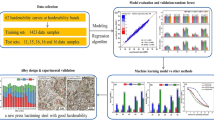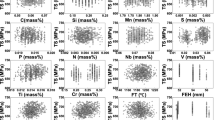Abstract
Pipeline transportation is one of the most economical ways to transport crude oil and natural gas over long distances. High toughness is one of the important qualities of pipeline steel to ensure safe transportation, wherein a key factor characterizing toughness is Charpy impact toughness (CIT). In this work, according to the production line data provided by a steel mill and the experimental data collected in literature, two machine learning model construction strategies were proposed. One was based solely on the production line dataset, and the other was based on the production line dataset together with the literature dataset. In these two strategies, the random forest model displayed the best prediction results, the accuracy of strategy I was 0.58, and the accuracy of strategy II was 0.90, wherein literature data effectively improved the CIT prediction accuracy. Finally, an optimized CIT model based on machine learning algorithms was established. The proposed strategy of literature data-assisted production line data provides a new perspective for optimizing and predicting the performance of traditional structural materials.
Similar content being viewed by others
References
Shanmugam S, Ramisetti N K, Misra R D K, et al. Microstructure and high strength-toughness combination of a new 700 MPa Nb-micro-alloyed pipeline steel. Mater Sci Eng-A, 2008, 478: 26–37
Bott I S, De Souza L F G, Teixeira J C G, et al. High-strength steel development for pipelines: A Brazilian perspective. Metall Mat Trans A, 2005, 36: 443–454
Wang C, Wang M, Shi J, et al. Microstructural characterization and its effect on strength of low carbon martensitic steel. J Mater Sci Technol, 2007, 23: 659
Kim H, Ha Y, Kwon K H, et al. Interpretation of cryogenic-temperature Charpy impact toughness by microstructural evolution of dynamically compressed specimens in austenitic 0.4C-(22–26)Mn steels. Acta Mater, 2015, 87: 332–343
Liu Y, Guo B, Zou X, et al. Machine learning assisted materials design and discovery for rechargeable batteries. Energy Storage Mater, 2020, 31: 434–450
Liu Y, Zhao T, Ju W, et al. Materials discovery and design using machine learning. J Materiomics, 2017, 3: 159–177
Zhou X Y, Zhu J H, Wu Y, et al. Machine learning assisted design of FeCoNiCrMn high-entropy alloys with ultra-low hydrogen diffusion coefficients. Acta Mater, 2022, 224: 117535
Fu H, Zhang H, Wang C, et al. Recent progress in the machine learning-assisted rational design of alloys. Int J Miner Metall Mater, 2022, 29: 635–644
Deng Z, Yin H, Jiang X, et al. Machine-learning-assisted prediction of the mechanical properties of Cu−Al alloy. Int J Miner Metall Mater, 2020, 27: 362–373
Pan G, Wang F, Shang C, et al. Advances in machine learning- and artificial intelligence-assisted material design of steels. Int J Miner Metall Mater, 2023, 30: 1003–1024
Zhang H, Fu H, Shen Y, et al. Rapid design of secondary deformation-aging parameters for ultra-low Co content Cu−Ni−Co−Si−X alloy via Bayesian optimization machine learning. Int J Miner Metall Mater, 2022, 29: 1197–1205
Lu Q, Liu S, Li W, et al. Combination of thermodynamic knowledge and multilayer feedforward neural networks for accurate prediction of MS temperature in steels. Mater Des, 2020, 192: 108696
Liu Y, Zou X, Ma S, et al. Feature selection method reducing correlations among features by embedding domain knowledge. Acta Mater, 2022, 238: 118195
Chen Y, Wang S, Xiong J, et al. Identifying facile material descriptors for Charpy impact toughness in low-alloy steel via machine learning. J Mater Sci Tech, 2023, 132: 213–222
Fürnkranz J, Gamberger D, Lavrač N. Foundations of Rule Learning. Berlin: Springer Science & Business Media, 2012
Jiang X, Jia B, Zhang G, et al. A strategy combining machine learning and multiscale calculation to predict tensile strength for pearlitic steel wires with industrial data. Scripta Mater, 2020, 186: 272–277
Matrosov Y I, Bagmet O A, Nosochenko A O. Development of modern heavy plate steels for pipelines. Trans Tech Publ, 2007, 539–543: 4756–4761
Kang M, Kim H, Lee S, et al. Effects of dynamic strain hardening exponent on abnormal cleavage fracture occurring during drop weight tear test of API X70 and X80 linepipe steels. Metall Mat Trans A, 2014, 45: 682–697
Wu Q, Zhang Z, Liu Y. Strain aging behavior of microalloyed low carbon seamless pipeline steel. ISIJ Int, 2016, 56: 126–131
Wu Q, Zhang Z, Liu Y, et al. Strain aging behaviour of Cu-containing microalloyed low carbon seamless pipeline steel. Mater Sci Tech, 2017, 33: 72–76
Zuo X, Zhou Z. Study of pipeline steels with acicular ferrite microstructure and ferrite-bainite dual-phase microstructure. Mat Res, 2015, 18: 36–41
Sha Q, Li D. Microstructure, mechanical properties and hydrogen induced cracking susceptibility of X80 pipeline steel with reduced Mn content. Mater Sci Eng-A, 2013, 585: 214–221
Zha C, Jiang Z, Wang W, et al. Research and development of heavy wall X80 transmission pipeline steel with high deformation characteristics for polar environments at Shougang Steel. Amer Soc Mech Eng, 2012, 45158: 249–255
Johnson J, Hudson M, Takahashi N, et al. Specification and manufacturing of pipes for the x100 operational trial. Int Pipeline Conf, 2008, 48593: 453–461
Seo D H, Yoo J Y, Song W H, et al. Development of X100 linepipe steel with high deformation capacity. Int Pipeline Conf, 2008, 48593: 585–592
Hillenbrand H G, Liessem A, Grimpe F, et al. Manufacturing of X100 pipes for the TAP Project. Int Pipeline Conf, 2006, 42630: 261–267
Yao S J, Du L X, Wang G D. Microstructure of Nb-bearing pipeline steel with improved property applying ultrafast cooling process. Steel Res Int, 2014, 85: 60–66
Beden S. Reliability of the installation and operation of pipeline systems. Basrah J Eng Sci, 2016, 16: 108–118
Yakubtsov I A, Poruks P, Boyd J D. Microstructure and mechanical properties of bainitic low carbon high strength plate steels. Mater Sci Eng-A, 2008, 480: 109–116
You Y, Shang C, Wenjin N, et al. Investigation on the microstructure and toughness of coarse grained heat affected zone in X-100 multiphase pipeline steel with high Nb content. Mater Sci Eng-A, 2012, 558: 692–701
Zhao M C, Yang K, Shan Y. The effects of thermo-mechanical control process on microstructures and mechanical properties of a commercial pipeline steel. Mater Sci Eng-A, 2002, 335: 14–20
Zhang J, Sun W, Sun H. Mechanical properties and microstructure of X120 grade high strength pipeline steel. J Iron Steel Res Int, 2010, 17: 63–67
Shin S Y, Woo K J, Hwang B, et al. Fracture-toughness analysis in transition-temperature region of Three American Petroleum Institute X70 and X80 pipeline steels. Metall Mat Trans A, 2009, 40: 867–876
Guo A, Misra R D K, Xu J, et al. Ultrahigh strength and low yield ratio of niobium-microalloyed 900 MPa pipeline steel with nano/ultrafine bainitic lath. Mater Sci Eng-A, 2010, 527: 3886–3892
Li J, Gao X, Du L, et al. Relationship between microstructure and hydrogen induced cracking behavior in a low alloy pipeline steel. J Mater Sci Tech, 2017, 33: 1504–1512
Shin S Y, Hong S, Bae J H, et al. Separation phenomenon occurring during the Charpy impact test of API X80 pipeline steels. Metall Mat Trans A, 2009, 40: 2333–2349
Hwang B, Kim Y G, Lee S, et al. Effective grain size and charpy impact properties of high-toughness X70 pipeline steels. Metall Mat Trans A, 2005, 36: 2107–2114
Li R, Zuo X, Hu Y, et al. Microstructure and properties of pipeline steel with a ferrite/martensite dual-phase microstructure. Mater Charact, 2011, 62: 801–806
Wang W, Shan Y, Yang K. Study of high strength pipeline steels with different microstructures. Mater Sci Eng-A, 2009, 502: 38–44
Wang W, Yan W, Zhu L, et al. Relation among rolling parameters, microstructures and mechanical properties in an acicular ferrite pipeline steel. Mater Des, 2009, 30: 3436–3443
Sung H K, Lee S, Shin S Y. Effects of start and finish cooling temperatures on microstructure and mechanical properties of low-carbon high-strength and low-yield ratio bainitic steels. Metall Mat Trans A, 2014, 45: 2004–2013
Yoo J, Jo M C, Bian J, et al. Effects of Nb or (Nb+Mo) alloying on Charpy impact, bending, and delayed fracture properties in 1.9-GPa-grade press hardening steels. Mater Charact, 2021, 176: 111133
Siahpour P, Miresmaeili R, Sabour Rouhaghdam A. Temperature effect of hot rolling process on microstructure, strength and fracture toughness of X65 pipeline steel. Trans Ind Inst Met, 2018, 71: 1531–1541
Zuo X, Li R. Research of strain aging in pipeline steel with a ferrite/martensite dual-phase microstructure. Steel Res int, 2015, 86: 163–168
Cheng S, Zhang X, Zhang J, et al. Effect of coiling temperature on microstructure and properties of X100 pipeline steel. Mater Sci Eng-A, 2016, 666: 156–164
Shin S Y. Effects of microstructure on tensile, charpy impact, and crack tip opening displacement properties of two API X80 pipeline steels. Metall Mat Trans A, 2013, 44: 2613–2624
Han S Y, Shin S Y, Seo C H, et al. Effects of Mo, Cr, and V additions on tensile and Charpy impact properties of API X80 pipeline steels. Metall Mat Trans A, 2009, 40: 1851–1862
Shin S Y, Gong G, Kim S, et al. Analysis of fracture toughness in the transition temperature region of API X70 pipeline steels rolled in two-phase region. Metall Mater Trans A, 2007, 38: 1012–1021
Hwang B, Lee C G, Kim S J. Low-temperature toughening mechanism in thermomechanically processed high-strength low-alloy steels. Metall Mat Trans A, 2011, 42: 717–728
Shin S Y, Hwang B, Lee S, et al. Correlation of microstructure and charpy impact properties in API X70 and X80 line-pipe steels. Mater Sci Eng-A, 2007, 458: 281–289
Zhao W, Chen M, Chen S, et al. Static strain aging behavior of an X100 pipeline steel. Mater Sci Eng-A, 2012, 550: 418–422
Jordan M I, Mitchell T M. Machine learning: Trends, perspectives, and prospects. Science, 2015, 349: 255–260
Zhang T Y. An Introduction to Materials Informatics: The Elements of Machine Learning. Beijing: Science Press, 2022
Filliben J J. The probability plot correlation coefficient test for normality. Technometrics, 1975, 17: 111–117
Chai T, Draxler R R. Root mean square error (RMSE) or mean absolute error (MAE)?—Arguments against avoiding RMSE in the literature. 2014, doi: https://doi.org/10.5194/gmdd-7-1525-2014
Romanski P, Kotthoff L, Kotthoff M L. Package ‘FSelector’. 2013
Xue D, Xue D, Yuan R, et al. An informatics approach to transformation temperatures of NiTi-based shape memory alloys. Acta Mater, 2017, 125: 532–541
Diao Y, Yan L, Gao K. A strategy assisted machine learning to process multi-objective optimization for improving mechanical properties of carbon steels. J Mater Sci Tech, 2022, 109: 86–93
Liu Y, Niu C, Wang Z, et al. Machine learning in materials genome initiative: A review. J Mater Sci Tech, 2020, 57: 113–122
Wang Y, Wagner N, Rondinelli J M. Symbolic regression in materials science. MRS Commun, 2019, 9: 793–805
Koza J R. Genetic programming as a means for programming computers by natural selection. Stat Comput, 1994, 4: 87–112
Author information
Authors and Affiliations
Corresponding authors
Additional information
This work was supported by the National Natural Science Foundation of China (Grant Nos. 52122408, 51901013, 52071023), H.H. Wu also thanks the financial support from the Fundamental Research Funds for the Central Universities (University of Science and Technology Beijing) (Grant Nos. FRF-TP-2021-04C1, and 06500135). The computing work is supported by USTB MatCom of Beijing Advanced Innovation Center for Materials Genome Engineering.
Supporting Information
The supporting information is available online at https://tech.scichina.com and https://link.springer.com. The supporting materials are published as submitted, without typesetting or editing. The responsibility for scientific accuracy and content remains entirely with the authors.
Rights and permissions
About this article
Cite this article
Shang, C., Wang, C., Wu, H. et al. Improved data-driven performance of Charpy impact toughness via literature-assisted production data in pipeline steel. Sci. China Technol. Sci. 66, 2069–2079 (2023). https://doi.org/10.1007/s11431-023-2372-x
Received:
Accepted:
Published:
Issue Date:
DOI: https://doi.org/10.1007/s11431-023-2372-x




